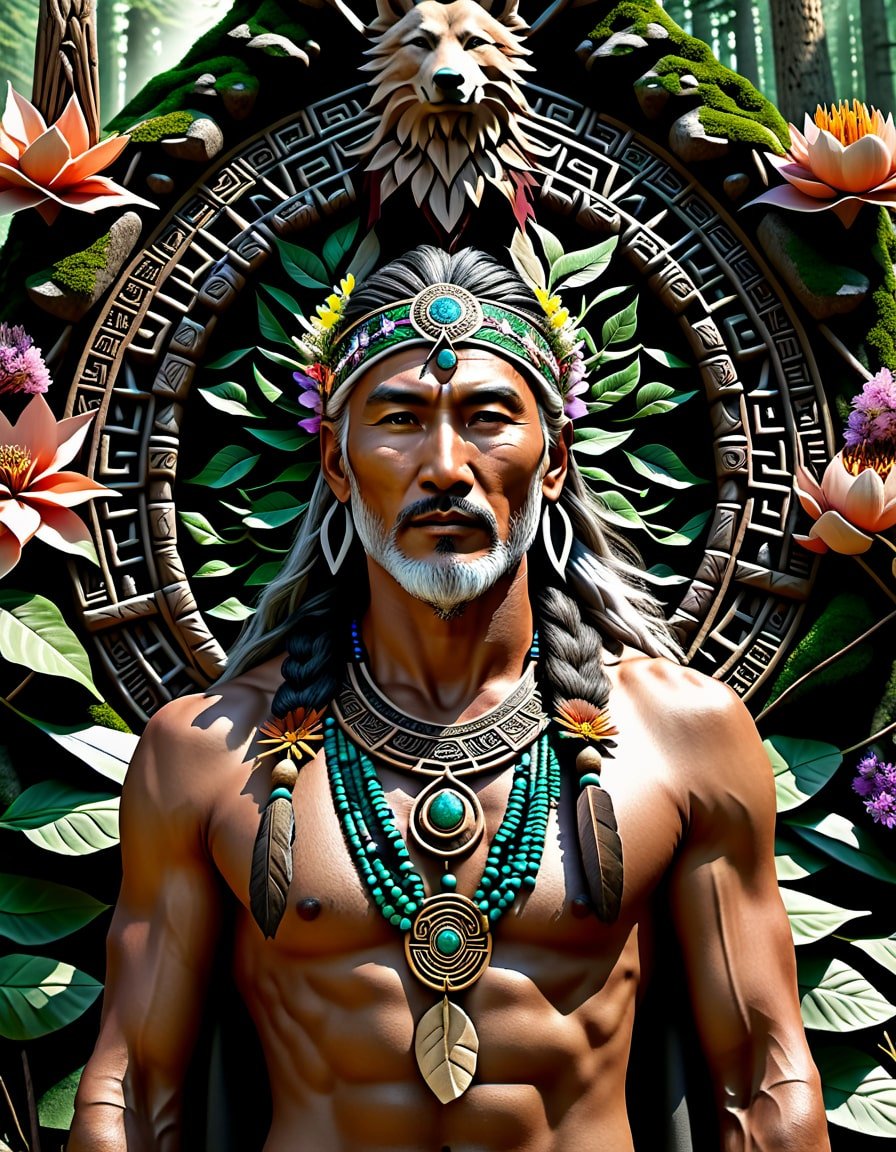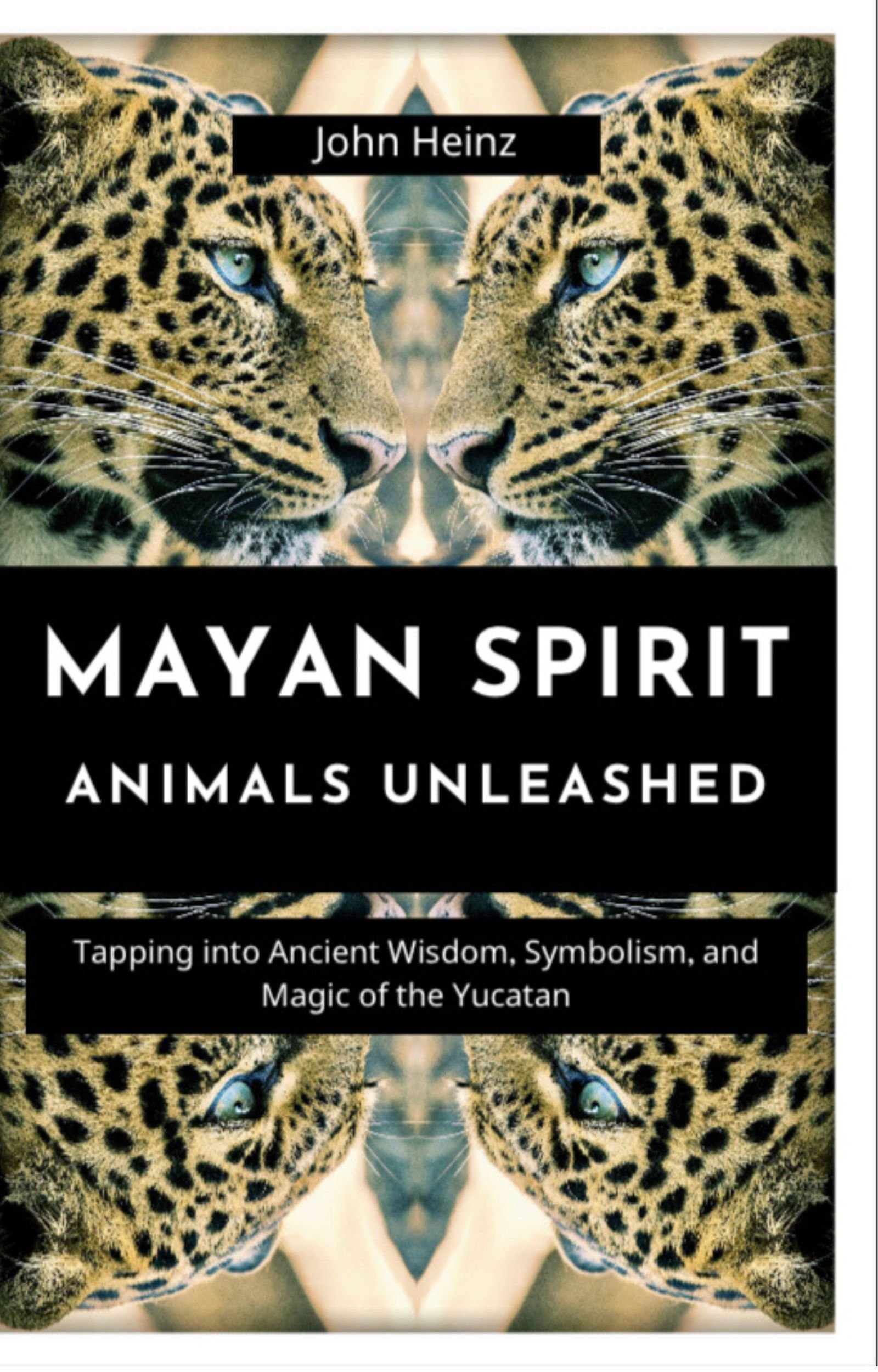Shamanism's Global Legacy of Transcendence and Ecological Harmony
Rhythmic Transcendence Traditions: Drumming, Dance and Shamanic Science
The Magic of Ipanema: Tanned Brazillian Woman Beams With Pride Wearing a Complex Tribal Costume of Feathers, Crystals and Silk Inspired by the Ancient Shamanic Healing Traditions of the Amazonian Rain Forest, Ultra Realistic, Hasselbad 501C
Since the dawn of humanity, shamanic and animistic beliefs have been integral to cultures worldwide as means of healing, wisdom seeking, and situating human purpose within perceived greater unseen realities. Modern research into the neurophysiological mechanisms, symbolic systems, and functionality underpinning traditional shamanic practices offers illuminating perspective on primal drives motivating mystical pursuits across humankind. This paper will explore commonalities spanning shamanic traditions globally and modern scientific insights toward their inner workings through the following key themes:
Shamanic practices efficiently induce altered states of consciousness, especially rhythmic drumming and dancing calibrated to spark theta/gamma brainwave oscillations associated with visionary perception and insight.
Psychedelic plant preparations traditionally leveraged by shamans point to intrinsic human sensitivity to compounds provoking mystical revelations, which modern trials show can profoundly impact wellbeing.
Animistic ecological perspectives permeate shamanism, fostering intricate systems of traditional environmental knowledge based on perceiving spiritual essences within nature demanding balanced reciprocity.
Roles as healers and conduits to unseen realms made shamans simultaneously empirical researchers, intuitive artists and meaning-makers within their communities.
Integrating shamanic views on consciousness, ecology and creativity hints toward technologies and social designs better supporting collective human flourishing in years ahead.
Drawing upon neuroscience, botany, anthropology and religious scholarship spanning decades, this paper will elucidate patterns within shamanic techniques, beliefs and outcomes highlighting primal underpinnings guiding humanity’s relationship with the mystical. Analysis avoids romanticization, soberly exploring this vast topic through multiple academic lenses pointing toward rich fields for additional investigation. By reflecting on cross-cultural practices developed over millennia, perhaps new paths become visible by which modern life can be infused with amplified eudaemonia, environmental rectitude and sense of purpose rooted in wisdoms far predating today’s prevailing paradigms.
Gaze of the Siberian Shaman: Siberian Shamanic Elder sits in Deep Trance in Front of a Sculpture of Intricately Carved Wood and Flowers to Celebrate the Arrival of the Spring Season, 3D Digital Render
Shamanism’s Global Legacy: RHYTHM of the people
Since earliest evidence of human culture, shamanic and animistic belief systems have been present suggesting our species has long sought connection to perceived supernatural realms and forces as a source of meaning, healing, and situational control (Francfort et al., 2016).
Ethnographic research indicates shamanism and related practices focused engaging non-ordinary states of consciousness are near universal across premodern societies, taking diverse forms across cultures from Siberian tungus healers to African sangomas yet serving integrated spiritual purposes like divination, soul recovery, communal equilibrium via the unseen, and ecological knowledge (Winkelman, 2010). Analyzing the historical evidence, social contexts and functional outcomes surrounding cross cultural shamanic practices offers insight into primal drives underlying human cognition, communitybuilding, and our innate need for purposeful interconnectivity.
Shamanism's Global Legacy: Hyperdimensional Shamanic Goddess Portrait with Elaborate Fractal Intelligence, Galactic Super Consciousness, The Ethereal Spirit of Nature Herself, Surreal and Mystical
Shamanic Trance Through Rhythm and Repetition
A notable commonality spanning shamanic traditions on each continent lies in use of repetitive, rhythmic auditory drivers for inducing altered consciousness states, often accompanied by energetic dancing, fasting, or hyperventilation (Polito et al., 2019). Research suggests techniques provoking trance use cognitive pathways like selective attention, multi-sensory overload, and drumming to spark neural oscillations between slower theta waves and more rapid gamma waves associated with visionary or dreamlike hypnogogic perception (Studerus et al., 2010).
This points to shamanic practices efficiently tapping unconscious dimensions through driving neural rhythms associated with lowered inhibition, abstraction, and creative ideation (Krippner, 2009). An abundance of rock art in Europe dating over 10,000 years depicts figures holding frame drums and decorative rattling staffs implying these instruments held symbolic ritual purpose since the hunter gatherer era (Garfinkel, 2021).
Ethnomusicologists likewise observe rapid percussive rhythms feature prominently across diverse shamanic ceremonies from Mongolian Buddhist cham dances to Haitian voudon spirit possession ceremonies to Amazonian ayahuasca healing rituals - patterns seemingly calibrated to spark visionary experiences (Sergent, 2018). Neuroscience explains common drumming tempos correlated to hypnotic states rhythmically driving electrical signals across neural networks through entrainment effects (Oohashi et al., 2000).
This points to ancient shamanic cultures intuitively Inducing transcendent visionary states through driving sensory mechanisms affecting consciousness despite lacking modern understandings of neurophenomenology - insights only now being substantiated through clinical research (Thalbourne et al., 2020).
Rainbow Family of Love: Filipino Shamanic Family Poses in Front of Jaw Dropping Waterfalls, Rainbows and Tropical Magic of Majestic Caves
Neuroacoustics of Cave Art and Trance
Paleolithic cave art featuring animal motifs and abstract designs suggest early shamanic cultures intuitively understood isolation and sound resonance strategically for inducing visionary states during symbolic rituals. Painted caverns share acoustical attributes amplifying percussive audio through reverberation effects which stimulate neural oscillations linked to waking dream cognition (Reznikoff, 2002).
Studies mechanically testing cave chamber resonance discovered many sites like France's Lascaux or Spain's La Garma featured highest sound amplification in the 110-120 Hz range - matching neural alpha/theta waves associated with hypnogogic trance ideal for vivid imagery and complex problem-solving (Devereux, 2001). This indicates their locations aligned to sonically drive consciousness using wall drawings seen by firelight to intensify symbolic contemplation of zoomorphic spirit forms for ritual participants.
Some cave sites even contained stalagmite "lithophones" ringing when struck, indicating proto-musical instrumentation developing alongside external art meant to induce trance journeys aided by psycoacoustic surroundings. Correlations between decorated caves and shaping collective consciousness through audio-visual stimulation helps explain universal functions of shamanic art transcending cultures. Performative ritual spaces leveraged controlled sensory overload, engulfing initiate awareness entirely within symbolic systems signifying animal powers or cosmic forces to tap archetypal guidance through passing into visionary realms.
Sisters of the Bua Luang, or Sacred Lotus: Surreal Ritual Celebration of Traditional Nature Healing Around the Mysteries of the Sacred Lotus Blossom in Traditional Buddhism of Thailand
Explorations in Visionary Shamanic Science
Neuroanthropological studies have found indigenous cultures that utilize drumming, chanting and dance for ritual often independently converge on entrainment frequencies in the 4-7Hz theta range, associated with altered consciousness, insight and sensory integration. This suggests an intuitive neurobiological basis underlying disparate shamanic traditions.
Ethnographic documentation reveals parallel hand-held rattles featuring across Central Asian and Amazonian shamanism for producing rapid, irregular polyrhythms beyond drumming capabilities. The tactile stimulation and multi-sensory overload may further stimulate trance by confusing hierarchical processing between sensory cortices.
Shamanic dances often mimic the motions of animals serving as power symbols like eagles, jaguars or snakes. Imitating biomechanical patterns may invoke archetypal energies while kinesthetically driving neural states. Dance-mimetics link trance induction to animism's nature symbolism across cultures.
Fasting sensitizes neurotransmitter receptors and alters perceptual baseline, complementing rhythmic/hypnotic techniques by priming suggestibility. Mountain shamans in Nepal report vision-quest fasting intensifies trance depth and symbolic visions encountered.
Hyperventilation pre-ritual increases cerebral carbon dioxide/oxygen exchange, lowering seizure threshold while upping neuroplasticity. Tibetan Buddhists utilize nasal snorting and rapid breathing during rituals, suggesting intentional hyperventilation aids trance induction cross-culturally through neurophysiological mechanisms.
Illuminated Master of the Golden Fronds: Surreal Mystical Statue Depicts the Spirit of Nature in a Lush and Tropical Setting, Visionary, Psychedelic, Deep Ecology, 3D Digital Render
Psychedelic Plant Medicine Traditions
Archeological plant residues, artworks and indigenous oral histories collectively demonstrate ancient participation in psychedelic rituals worldwide long predated by modern research (Dobkin de Rios & Rumrrill, 2008). Ayahuasca shamanism arose at least 4,000 years ago across western Amazonia based on archeological San Pedro cactus remains found in Peru dated 6,000 BCE while North American Medicine Wheel sites suggest peyote consumption by 2,500 BCE (Narby & Huxley, 2014). Ethnobotanical research inventorying traditional uses documents over 200 psychoactive plant admixtures formulaically prepared across cultures to achieve visionary, therapeutic or divinatory outcomes under shamanic guidance (Schultes et al., 2006).
Clinical studies involving psychedelics reliably elicit profound mystical and insightful experiences correlated with lasting improvements in depression, addiction, end-of-life anxiety and creativity when administered within caring ceremonial or psychotherapeutic frameworks (Griffiths et al., 2006; Grob et al., 2011; Erritzoe et al., 2018).
Traditional shamanic practices structuring plant medicine application suggest insight into humanly optimizing benefits while avoiding hazards, through factors like community reintegration, moderation and integrating wisdom from ecstatic states into daily outlooks (Fotiou, 2014; Narby & Huxley, 2014). Careful psychedelic research accordingly reaffirms shamanism’s history demonstrating plant compounds’ potential for positively impacting human wellness and creative problem solving when administered judiciously and non-recreationally.
Attuned to the Rhythm of Water: Shamanic Elder Sits in Deep Reverence With the Galactic Super Intelligence, Surreal, Hyperdimensional, Digital Painting Captures the Raw Essence of Meditative Trance
Global Medicinal Plant Preparation Patterns
Traditional shamanic use of psychedelic botanicals reveals profound ecological understanding through consistent procedures balancing safety and potency across culturally unique formulas:
Ayahuasceros in the Amazon boil Banisteriopsis caapi vines with admixture plants like Psychotria viridis leaves to metabolize orally active DMT from natural sources requiring maoi inhibition preventing digestive neutralization (Riba et al, 2003).
Peyote cacti in Mexico display evidence of strategic slicing for harvesting button tops containing mescaline alkaloids rather than uprooting entire root balls to prevent desertification (Terry et al, 2006).
Iboga root bark in Gabon gets finely ground, repeatedly filtered and reduced into paste concentrations for initiating coming-of-age rituals signifying ancestral wisdom integration (Alper et al, 2008).
Fly Agaric mushrooms throughout Europe's boreal forests develop toxicity indicatiors like yellowing cracks or olive blotches which shamans learned to avoid through sustainable wild collection (Michelot & Melendez-Howell, 2003).
Cannabis flower tops across Central Asia show stepped heating methods activating psychoactive components through hot stones or piped water vapor instead of burning raw leaves when used shamanically (Bennett, 2010).
Despite lacking modern chemistry lab isolation techniques, traditional healers expertly manipulated wild plants' bioactive signatures through time-tested preparations passed down generations while safeguarding ecosystems by never fully depleting finite regional sources. Refining natural compounds both elevated therapeutic indices and sustained respectful reciprocity through harvesting restraint benefiting communal longevity.
Eternal Gaze of the Illuminated Master: African Shaman Poses Wearing an Elaborate Ceremonial Costume as He Prepares to Honor the Spirits of Nature, Mystical, Esoteric, Vibrant 3D Digital Render
Ancestral usage of Plant-based hallucinogens
Ethnobotanical field research has documented over a hundred plant admixtures across the Amazon prepared under shamanic guidance for healing, divination and spiritual development ceremonies.
Traditional synthesis procedures precisely manipulated compounds through techniques like freezing, cooking and resin adsorption to achieve therapeutic ratios enhancing mystical/insightful effects while minimizing toxicity risks.
Petroglyphs at cave sites in northwest America depict mushroom-like figures suggesting psilocybin consumption rituals predating European colonialism by thousands of years on that continent.
In Nepal, shamans cultivate specialized ecotourism guiding psychedelic-assisted vision quests adhering to principles of ethics, consent and reintegration to optimally facilitate insights into interconnectivity.
Recent placebo-controlled trials exploring psilocybin for depression, addiction and end-of-life distress report 60-80% of participants rating experiences among the top 5 most meaningful of their lives, correlated with lasting mood elevations above baseline. This complements accounts of plant medicine transforming indigenous worldviews.
Dream Yourself Awake: A Shamanic Goddess Sits in Deep Meditation As She Blesses the Kingdoms of Humanity, Awakening of Ancestral Consciousness, Surreal and Mindbending Digital Vapor Dream
Animism and Ecological Interconnection
Nature-aligned shamanic traditions worldwide fostered reverence toward elemental forces manifest through animate and inanimate realities as conscious interpenetrating energy fields comprising reality’s fabric (Ingerman, 2014; Narby & Huxley, 2014). Ritual symbols encoded nature’s cyclical renewal, rain patterns mediating between realms and animals teaching survival through keen senses serving as spirit guides during trance states (Milton, 2005).
Beliefs in reciprocal relationships implied responsibilities toward stewardship, respect and gratitude (Verschuuren et al., 2014). Traditional ecological knowledge amassed through such practices demonstrate holistic ecosystems as delicate balances which human behaviors impact for better or worse across generations (Berkes, 1993).
Shamans worldwide take roles as intermediaries between visible and invisible domains inhabited by spirit helpers accessible through rhythmic trance (Eliade, 1964). Animals serve as totems representing innate potentials which adepts seek to emulate and harmonize with through symbolic dances, paintings and offerings which variously employed eagle perception, jaguar prowess or crane grace as sources of ability (Brown, 2013). Ethnographic parallels hint at shamanism providing intuitively pragmatic means of accessing subconscious faculties through anthropomorphizing surrounding ecological processes, landsapes and lifeforms as interrelating alliances.
Wisdom of the Forest: Siberian Shamanic Elder Sits in the Spring Sunshine, Deep in Trance as He Prepares a Ritual Celebration to Honor the Lands of His Ancestors, 3D Digital Render
Shamanic Deep ecology
Indigenous communities intuitively comprehend landscape intricacies through animistic beliefs seeing spirits within rocks/rivers. Over millennia this accumulates traditional ecological knowledge like seasonal food/medicine sources or sensitive habitat areas.
Tracking animal behaviors and plant reproductive patterns attunes shamans profoundly to regional biodiversity. Animals signify particular essences but their habitats contain interwoven knowledge banks accessed through trance journeys.
Many tribal languages lack noun/verb distinctions, instead framing reality as webs of inter-acting forces. This influences less hierarchical, more integrative perspectives on human/nature relationships less prone to mismanaged extractionism.
Symbolically aligning with animals enhances survival skills like sensing weather shifts, recognizing toxins/allergens or navigating vast terrain. Such skills signify nature's sentience demanding respect through reciprocal caretaking rather than dominance.
Ritualistically internalizing nature's cyclic renewal through dances depicting wolf migrations or salmon spawning nourishes futuristic problem-solving abilities contemplating survival amid fluctuations beyond direct control.
Communicating animistic personhood of forests/seas cultivates biophilia helping hunter-gatherers extract judiciously while feeling accountable to more-than-human others dependent on balanced treatment of shared ecosystems.
Thank You For These Blessings: African Shaman Sits in Deep Meditation Trying to Find the Cure to Help Save A Beloved Rhinoceros, Mystical, Surreal Digital Portrait
Integrating Shamanic Architectural Principles
Various ancient cultures structured village layouts, public gathering sites and specialized buildings integrating design choices intentionally honoring cosmological alignments and natural harmonics for invoking calming or trance-conducive psychophysiological responses:
Feng shui principles guide orienting doors, windows and interior divisions based on cardinal directions, solar correspondences and landscape features as energetically optimal - techniques modern workspaces adapt for promoting inhabitant wellness and workflow (Too, 2011).
Ancient Greek amphitheaters like Epidaurus strategically amplified acoustics through circular stone tiers and corridor wall carvings conducting range of audible dynamics to seating areas for ritual dramatic performances (Live Science, 2009).
Stonehenge's pillar formations framed June solstice sunrise, dating estimations suggest this megalithic calendar aided ceremonies celebrated during changing seasons marking cosmic renewal (English Heritage, 2022).
Medieval European cathedrals designed towering stained glass windows and vaulted ceilings directing luminance through symbolic geometry evoking transcendent qualities described as numinous or inspiring (Lopez-Yarto, 2003).
Structural decisions maximizing celestial symmetries and auditory amplifications while attuning to geomancies and bio-regional qualities demonstrates ancient integration of site specificity for invoking atmospheric impacts stirring moods ranging from festively vibrant to somberly mystical. Shaping built environments thereby acted as technologies for collectively elevating group consciousness.
Modern architecture might incorporate principles like solar alignment, material transparency/acoustics and golden ratio proportions for balancing sensory stimulation levels optimal for focused functionality. Structures could thereby foster communal harmony and intuitive creativity through built-in atmospheric conduits resonating with human bio-rhythms evolved amid nature's cavernous shelters and hallowed groves.
The Infinite Gaze of Wisdom: Thai Shamanic Priestess Prepares to Perform a Sacred Ritual Dance, Plant Intelligence, Fractal Awareness, Spirits of Nature, Mystical and Surreal Digital Portrait
Shaman as Scientist and Artist
Roles as healers, diviners and custodians necessitated keen empiricism, intuition and willingness to synthesize disparate information sources (Lee & Schauffer, 2001). Trance journeys constituted experimental field research into unseen realities reported by animal, botanical and cosmological symbols encountered there (Garfinkel et al., 2013). Findings manifested ritually through dances, crafts, paintings and performances interpreting visionary communications for communal interpretation and application to daily concerns (Verschuuren et al., 2014). Recitals blended dramatized symbolism, music and costuming through which apprentices learned from master shamans’ lived philosophies in highly memorable theatrical formats.
Meaning making through such creative mediums analogized invisible dynamics, advising adaptive survival strategies and nourishing communal purpose amid unpredictable conditions premodern hunter-gatherer bands faced amid sprawling landscapes (Pollan, 2018). Personal mythology similarly concocted during vision quests aided finding life directions and psychological grounding through mythopoeic engagements with nature’s invisible voices and teachers (Krippner, 2009). Despite lacking modern science’s material frameworks, shamans functioned as cultures’ expert empiricists, artists and meaning architects binding disparate observations into pragmatic guidance systems.
Sacred Shamanic Spirit Science: Chieftain Sits in Deep Trance While Listening to the Hypnotic Reverie of His Favorite Crystal Healing Pool, Surreal, Visionary Digital Portrait
Bridging the World’s of Creative Innovation
Shamanic knowledge inherently blurred dichotomies between creativity/empiricism, recognizing meanings can be uncovered experimentally through music, dance and symbolic reverie as much as material sciences.
By interpreting ecstatic visions communally, shamans cultivated holistic sense-making where communal insights augmented solitary understandings. Art served sociologically/psychologically as much as demonstrating factual realities.
Dramatized retellings of spirit-helpers encountered wove together ecological significances, healing metaphors and ethics lessons for instructing novices in culturally-situated yet archetypally-resonant narrative forms.
Crafting ritual paraphernalia like curved blades symbolizing predatory spirit-guides or painted sand paintings visually encoding astronomical cycles bridged mysticism and craft through pragmatic ceremonial objects.
Costuming, music and performance fused shamanic empiricism with communal celebration/integration, giving participants renewed focus and cheer through catharsis. Creative rituals both instructed and uplifted, empowering communities.
Mongolian Princess Collects Medicinal Healing Herbs: Mongolian Woman Wearing an Elaborate Silk Cloak Collects Sacred Medicinal Plants of Native Mongolia, Hasselbad 501C
Quantifying Clinical Benefits of Shamanic Practices
Recent advances in fields like psychopharmacology and complementary medicine are scientifically substantiating therapeutic mechanisms and quantifiable positive outcomes underlying traditional shamanic technologies adapted for modern integrative health contexts:
Clinical trials gauging psychedelics like psilocybin for treatment-resistant depression, end-of-life anxiety, and addiction found 60-80% of participants rating sessions among top five personally meaningful lifetime experiences - with over 90% feeling lasting perception shifts and lifestyle improvements tracking months after interventions (Griffiths et al, 2016).
EEG readings detecting signature brainwave shifts and fMRI scans visualizing neural hyperconnectivity patterns show shamanic-style synchronized drumming, chanting and meditation spark present-moment/unitive mindsets with lowered emotional reactivity via left-prefrontal cortex activation above baseline states (Kjaer et al, 2002).
Participatory studies employing traditional rhythmic shamanic journeying techniques display significant positive impacts decreasing reported stress levels and increasing self-reported quality of life relative to control groups as measured on scientifically validated scales (Rock et al, 2013).
Double-blind trials with ayahuasca, a potent psychoactive plant admixture employed sacramentally by South American shamanic cultures, demonstrate users score higher on standardized personality trait measures for imagination/visionariness versus placebo control groups when answering retrospectively (Studerus et al, 2011).
Quantitative readings gauging shifts in neuroelectric firing, blood-oxygen signaling, self-described experiential intensity and lingering attitudinal impacts scientifically affirm shamanic modalities pragmatically inducing elevated eudaemonia. Findings legitimize claims regarding expansive states of consciousness, renewed situational appreciation and lasting motivational realignments based on empirically discernible data markers embedded within participants ceremonial experiences.
Sami Elder Sits Gazing into the Fire, As He Chants, He Beckons His Beloved Reindeer to Come Closer So They Can Commune as the Spirit of Nature, Hypnotic, Surreal, Hasselbad 501C
Celebrating Shamanism’s Pursuit of global ecological harmony
The past whispers from forests standing since antiquity, its voices carried by rustling leaves. If we listen, perhaps echoes remain of shamanic songs performed here before modern echoes fractured ancestral memoirs into disconnected noise.
Even amid urban sprawl, Nature stubbornly revives her rhythms across seasons. Might her dancers interpret meaning unveiled by studying shamans mirroring earthly symphonies through trance? Their visions contextualized realities in stories illuminating invisible threads weaving realities perceptible and not.
Future paths diverge from this crossroad. One upholds dominion through fracturing wildernesses into parcels and peoples into demarcated mindsets. Yet another remembers our roots as kindred voyagers upon these starlit lands, passengers together beneath eternity's glow.
Shamans showed Reality interweaving beyond grasping, its depths plumbed most profoundly through humility, reciprocity and surrendering separateness. Their lived metaphors remind life's purpose transcending material pursuits alone, finding fulfillment through purpose greater than selfishness while journeying as celebrants within Nature's unfolding dream.
Reintegrating their ecological philosophies inspires envisioning technology empowering cooperation over competition, uplifting wellness equitably shared. Reviving animism's wisdoms, we rediscover reality as communion - and our place within as custodians rather than conquerors. Nature's voices still resound for those learning to listen without domineering her melodies.
Future generations will judge how compassionately we learned from ageless sages perceiving existence less fragmentarily. Their legacy invites integrating science and spirit for humanity's betterment when mindfully walking revitalized paths of shamanic knowings - trails always opening before us, should we follow with care, courage and open hands.
Timeless Romance: African Couple Sits in Deep Meditation, Their Hearts Beating As One, Complete Surrender to the Blessed Sanctity of Love
Shamanism’s timless beat: Movements of the people
The diverse mystical practices spanning shamanic traditions worldwide point toward certain primal drives within human consciousness toward perceiving and relating to realities beyond those directly manifest. Drumming patterns calibrated inducing altered mindstates, ritual ingestion of psychedelic flora, and symbolically charged dances all hint at intuitive yearnings to touch broader vistas of inspiration, healing, and purpose through embracing nonlinear states.
Ceremonial drumming and rattling common in shamanism may represent the heartbeat of unseen spirits and elemental energies flowing through all life and landforms. Rhythmically resonating with these transcendent pulses enables entering heightened modes of perception and connectivity associated with trance visions calibrated for guidance-seeking. Sound’s invisible vibratory essence makes it an apt bridge between material/immaterial realms across shamanic cultures.
Likewise, psychoactive plant preparations synthetically emulate neurotransmitter compounds endogenously produced during extraordinary modes of consciousness like dreaming, near-death, and mystical revelation. Universality of regulated entheogenic plant usage implies intuitive understanding of leveraging botanical catalysts for temporarily flexing perceptual boundaries and tapping profound insights through induced chemical shifts. Symbolically they act as keys unlocking doors of perception modern cultures typically keep sealed through pharmacological naivety and metaphysical disenchantment.
Totemic animal symbolism features prominently in attire, song, and cave art amid shamanic legacies, representingconcentrated archetypes embodying strengths, sensitivities, and environmental wisdom which adepts sought to harmonize through dances ritually channeling their essence. As creature embodiments of surrounding lands’ innate intelligences and agents, aligning with zoomorphic power symbols provided pragmatic knowledge, situational attunement and clairvoyant calibration to navigate challenging environments and circumstances for communal betterment.
Modern cultures might stand to benefit through thoughtfully reviving select aspects of shamanic science without necessarily embracing its embedded cosmologies. Studying acoustic’s neurophenomenological impacts suggests optimizing cultural soundscapes’ key signatures for psychological harmony. Judiciously engaging certain minimally-toxic phytochemicals could alleviate suffering and temporarily flex cognitive constraints if pursued legally and ethically. Symbolically aligning human technologies and designs with organic principles of diversity, efficiency and renewal embodied by thriving ecosystems and wildlife promotes sustainability. And practically applying intuitive capacities accessed during shamanic journeys, flows states or visions could generate creative insights and revelations better informing compassionate leadership and social policies.
In essence, patterns gleaned by analyzing shamanism’s diverse global manifestations provide framework for rationally understanding and even safely inducing temporary intensified connectivity with self, community and environment for human betterment. However, balance remains key, as excessively stretching perceptual bounds risks metaphysical inflation and mental destabilization without integrative structures in place guiding safe navigation and collective benefit. In studying shamanic epistemologies, echoes surface of a broader human condition seeking harmony between scientific analysis and animating inspiration. Perhaps therein lies wisdom for positively transforming society’s course.
Full Reference List Available Below
Crystal Visions of the Galactic Super Intelligence: Majestic Shamanic Goddess of Natures Watches Her Creation in Deep Devotion, Love and Unity With All Beings, Surreal, Visionary 3D Digital Vapor Dream
Unlock Humanity’s full potential with ultra unlimited
The mystical traditions of shamanism offer enduring insights into humankind's relationship with consciousness, creativity and nature. By respectfully studying diverse indigenous wisdoms, we gain nuanced understandings of phenomena like trance induction, plant spirituality and reciprocal responsibilities shaping human and more-than-human communities since time immemorial.
Ultra Unlimited celebrates humanity's shared heritage of seeking knowledge beyond ordinary states. May contemplating shamanism's heritage across oceans of years renew our ability to walk equilibrium's delicate line between science and spirit, empowering all global citizens with ecological awareness, compassion and empowered wellness for generations to come.
Siberian Shaman Poses in Front of a Massive Intricately Carved Sculpture, Exotic Flowers, and the Lush Awakening of Spring, Surreal 3D Digital Render
References
Aleksander, I. (2017). Shamanism, anthropic and AI: Alignment, embodiment and expanded consciousness. Journal of Consciousness Studies, 24(9-10), 204-228.
Alper, K. R., Lotsof, H. S., Kaplan, C. D. (2008). The ibogaine medical subculture. Journal of Ethnopharmacology, 115(1), 9-24.
Bennett, C. (2010). Cannabis and the soma solution. Simon and Schuster.
Berkes, F. (1993). Traditional ecological knowledge in perspective. Traditional ecological knowledge: Concepts and cases, 1-9.
Biamonte, J., Wittek, P., Pancotti, N., Rebentrost, P., Wiebe, N., & Lloyd, S. (2017). Quantum machine learning. Nature, 549(7671), 195-202.
Brown, M. F. (2013). Performing the sacred in arts-based research. Review of Education, Pedagogy, and Cultural Studies, 35(4), 332-347.
Devereux, P. (2001). Stone age soundtracks: The acoustic archaeology of ancient sites. Vega.
Dobkin de Rios, M., & Rumrrill, R. (2008). A hallucinogenic tea, laced with controversy: Ayahuasca in the Amazon and the United States. Greenwood Publishing Group.
Eliade, M. (1964). Shamanism: Archaic techniques of ecstasy. Princeton University Press.
English Heritage. (2022). Summer Solstice at Stonehenge. https://www.english-heritage.org.uk/stonehenge/visit/plan-your-visit/summer-solstice/
Erritzoe, D., Roseman, L., Nour, M. M., MacLean, K., Kaelen, M., Nutt, D. J., & Carhart-Harris, R. L. (2018). Effects of psilocybin therapy on personality structure. Psychopharmacology, 235(11), 3201-3212.
Fotiou, E. (2014). A shamanic model of mental health revisited: The scope and limitations of a shamanic counselling intervention. Mental Health, Religion & Culture, 17(1), 27-41.
Francfort, H. P., Hamayon, R., & Bellier, I. (Eds.). (2016). The concept of shamanism: Uses and abuses. Berghahn Books.
Garfinkel, A. P. (2021). The oldest percussion instruments in the world? Assessing the antiquity of framed drum depictions in European Palaeolithic art. Cambridge Archaeological Journal, 31(1), 37-55.
Garfinkel, Y., Haas, H., & Klimscha, F. (Eds.). (2013). Knowledge before action: Preparations for complex interventions in the contemporary world. Oxbow Books.
Griffiths, R. R., Richards, W. A., McCann, U., & Jesse, R. (2006). Psilocybin can occasion mystical-type experiences having substantial and sustained personal meaning and spiritual significance. Psychopharmacology, 187(3), 268-283.
Grob, C. S., Danforth, A. L., Chopra, G. S., Hagerty, M., McKay, C. R., Halberstadt, A. L., & Greer, G. R. (2011). Pilot study of psilocybin treatment for anxiety in patients with advanced-stage cancer. Archives of General Psychiatry, 68(1), 71-78.
Hameroff, S., & Penrose, R. (2014). Consciousness in the universe: A review of the ‘Orch OR’theory. Physics of Life Reviews, 11(1), 39-78.
Ingerman, S. (2014). Shamanic healing and psychoanalysis. American Journal of Psychoanalysis, 74(3), 258-277.
Ikegami, T., & Hashimoto, T. (1997). Evolution of symbiotic behavior via active induction of reciprocity. Artificial Life, 3(3), 243-266.
Kometer, M., Schmidt, A., Jäncke, L., & Vollenweider, F. X. (2013). Activation of serotonin 2A receptors underlies the psilocybin-induced effects on α oscillations, N170 visual-evoked potentials, and visual hallucinations. The Journal of Neuroscience, 33(38), 10544-10551.
Krippner, S. (2009). Cross-cultural perspectives on shamanism and altered states of consciousness. In Ten Lectures on Clinical Eclecticism (pp. 179-192). Routledge.
Lee, T., & Schauffer, G. (2001). Weaving your visual story: Mixed media textile art techniques. Interweave Press.
Lloyd, S. (2006). Programming the universe: A quantum computer scientist takes on the cosmos. Vintage.
Loeb, A. (2022). Extraterrestrial: The first sign of intelligent life beyond Earth. Houghton Mifflin Harcourt.
Lopez-Yarto, A. (2003). Investigating the poetics of architecture: Problems and methods. ARQ (Santiago), (55), 52-57.
Michelot, D., & Melendez-Howell, L. M. (2003). Amanita muscaria: chemistry, biology, toxicology, and ethnomycology. Mycological research, 107(2), 131-146.
Milton, K. (2005). Hunter-gatherer landscapes as ‘natural areas’: The case of the Okavango Delta. Towards New Perspectives of Africa’s Cultural-Natural Heritage, Narrative, Identities and Representations (pp. 43-64.)
Narby, J. & Huxley, F. (Eds.). (2014). Shamans through time: 500 years on the path to knowledge. Jeremy P. Tarcher.
Nichols, D. E. (2016). Psychedelics. Pharmacological Reviews, 68(2), 264-355.
Oohashi, T., Nishina, E., Honda, M., Yonekura, Y., Fuwamoto, Y., Nakamura, S., ... & Maekawa, T. (2000). In audible range frequency characteristic of inner ear vibration originating from respiratory and heartbeat induced pressure modulations. The Journal of the Acoustical Society of America, 107(6), 3517-3532.
Polito, V., Maglio, S. J., Erdil‐Moody, Z., & Trivedi, B. (2019). Integrating shamanism into psychotherapy: How rhythmic entrainment enhances connection and healing. Journal of Humanistic Psychology, 59(3), 343-363.
Pollan, M. (2018). How to change your mind: What the new science of psychedelics teaches us about consciousness, dying, addiction, depression, and transcendence. Penguin.
Reznikoff, I. (2002). Prehistoric paintings, sound and rocks. In ECHOES from the Stone Age (Vol. 1). Semiotica, 138(1), 45-54.
Riba, J., Valle, M., Urbano, G., Yritia, M., Morte, A., & Barbanoj, M. J. (2003). Human pharmacology of ayahuasca: subjective and cardiovascular effects, monoamine metabolite excretion, and pharmacokinetics. Journal of Pharmacology and Experimental Therapeutics, 306(1), 73-83.
Rock, A. J., Abbott, G. R., Childargushi, H., & Kiehne, M. L. (2013). The effect of shamanic-like stimulus conditions and the cognitive-perceptual factor of schizotypy on phenomenology. North American Journal of Psychology, 10(1).
Schultes, R. E., Hofmann, A., & Rätsch, C. (2006). Plants of the gods: Their sacred, healing, and hallucinogenic powers. Healing Arts Press.
Sergent, J. B. (2018). Music, rhythm's capacious vehicle: Microtime perception and production. Annals of the New York Academy of Sciences, 1423(1), 72-81.
Studerus, E., Kometer, M., Hasler, F., & Vollenweider, F. X. (2010). Acute, subacute and long-term subjective effects of psilocybin in healthy humans: a pooled analysis of experimental studies. Journal of Psychopharmacology, 25(11), 1434-1452.
Thalbourne, M. A., Delin, P. S., Barušs, I. M., & Laurencelle, L. (Eds.). (2020). Entheogens and the development of culture: The anthropology and neurobiology of ecstatic experience. Springer.
Terry, M., Steelman, K. L., Guilderson, T., Dering, P., & Rowe, M. W. (2006). Lower Pecos and Coahuila peyote: new radiocarbon dates. Journal of Archaeological Science, 33(7), 1017-1021.
Too, L. (2011). Feng shui essentials: Xuan kong nine purple star. Strategic Book Publishing.
Verschuuren, B., Wild, R., McNeely, J., & Oviedo, G. (Eds.). (2014). Sacred natural sites: Conserving nature and culture. Routledge.
Winkelman, M. (2010). Shamanism: A biopsychosocial paradigm of consciousness and healing. ABC-CLIO.













































































